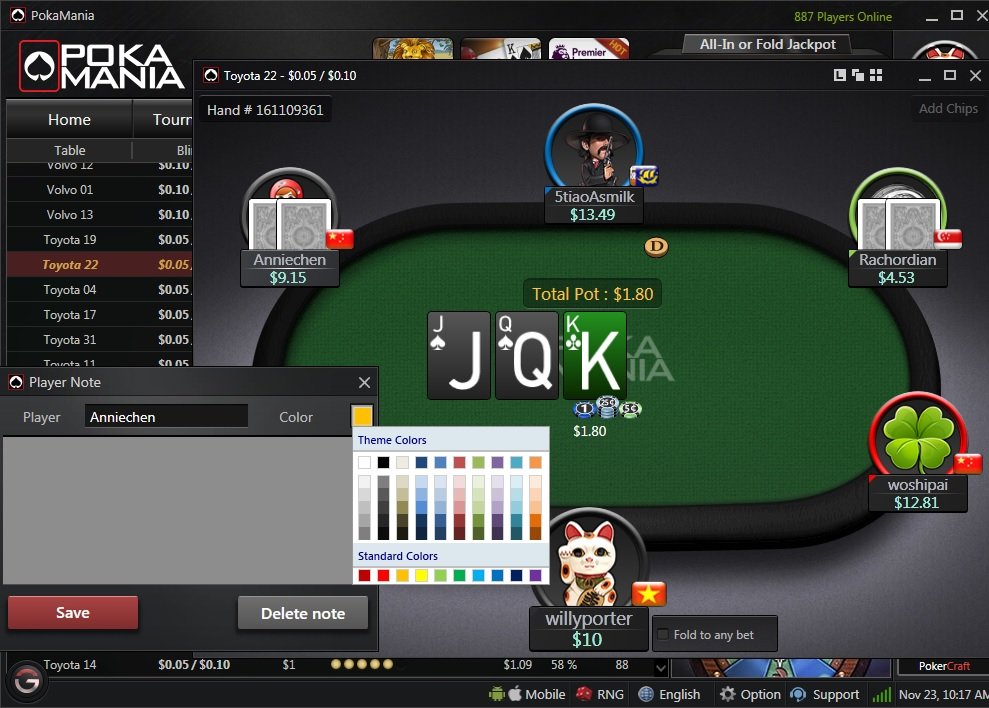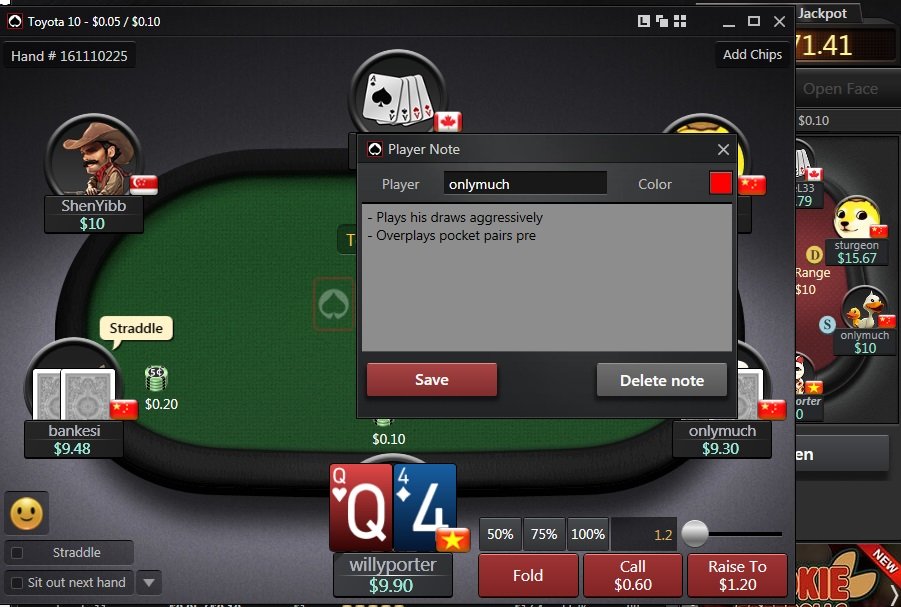Poker is a game of partial information. Players constantly have to work out what the missing pieces are to the particular puzzle facing them in any given moment. It stands to reason then that the more information a player has available, the more accurate their decisions will become.
Studying the way that your opponents play and taking notes on them has always been a great way to accumulate valuable information tailored to each opponent that you face regularly.
In this article, we aim to give you three steps you can use if you don’t know how to get started with note taking.
Step #1: Categorize your opponent
Colour coding players at your table is an important aspect of note taking, because it allows you to see at a quick glance what sort of player you are dealing with.
It not only helps when you are involved in a tricky situation in a hand, but also when you are selecting which table to play.
If you see a few players you have marked as very good players, and no players marked as very weak, you can simply wait for a better table.

Below, you will find our suggestions but choosing your own system is absolutely fine. The important point here is that you want information, even if it’s very general, that you can see at a glance.
Colour coding players based on a few hands you’ve seen can sometimes lead to inaccurate assumptions, but it’s not the end of the world. The great thing about colour coding is that it can easily be changed.
Green – Overly passive weak players that exhibit behaviours such as limping, only raising with strength and calling a lot.
Blue – Overly aggressive weak players who love to bluff, even when their line doesn’t make much sense.
Orange – Regular players who seem to play a solid tight-aggressive game and don’t seem to get way out of line post-flop.
Red – Skilled regulars who don’t seem to make mistakes and can put you in very difficult post-flop situations.
Step #2: Spot betting patterns
When you are done with colour codings, start to identify betting patterns.
Betting pattern notes can be a beautiful thing, and can end up doing wonders for your bankroll. If you have one player at a table that has a bet sizing tell which you have marked as a certainty, you need to get into that game. Someone betting half-pot for value and two-third pot when bluffing will be incredibly easy to play against.

If you don’t have something as concrete as that to put in your notes, try taking notes on the following things:
“Plays his draws aggressively” – If an opponent always plays open end straight draws and flush draws very fast or passively on the flop, it can of course aid your flop decisions. But, it can also help river decisions. If someone always plays draws fast on the flop, you can still happily make that value bet on the river when the flush comes in and your opponent has called flop and turn.
“Overplays pocket pairs pre” – Sometimes you will meet players who are so averse to playing middle pairs that they always just try to 4-bet or 5-bet jam them pre to avoid awkward spots and lock up some fold equity. This is useful to have in your notes if you are facing a shove preflop and attempting to define a range.
“Slow-playing the nuts on drawy board” – This is useful to know, especially if a player does it even when the board is draw heavy. If a player never floats and always slow-plays strength, having that info in your notes saves you money whenever you see them making a dreaded flop call, followed by turn call, before shoving a blank river.
“Min raise top pair no kicker for info” – It’s a betting pattern that can be seen among a lot of weak players. Facing a c-bet they will raise to test the strength of their hand vs yours. If you spot a player doing that, you will make a lot of money exploiting them by bluffing when you have nothing and just calling the nuts.
Step #3: Complete hand
After categorising a player and identifying the most relevant betting patterns, you may want to start building up a history of more precise information.
In order to be as precise as possible you can add under the betting patterns the description of a full hand that has been particularly interesting. This ill ensure that you have more solid material to analyse.
Abbreviate in order to make the information easier to digest. For example:
Raise with pocket TT heart and diamond with button. Bet pot on 678 of clubs board. Check-call on 8 of hearts turn. And, check-call river on a 5 of clubs.
Can become: R ThTd (btn) – Pot 6c7c8c – X/C 8h – X/C 5c.
With this information, you can think over a past situation quickly and clearly without needing a fresh memory. It will also be useful if you want to discuss a hand with your friends later.
Article by Craig Bradshaw




